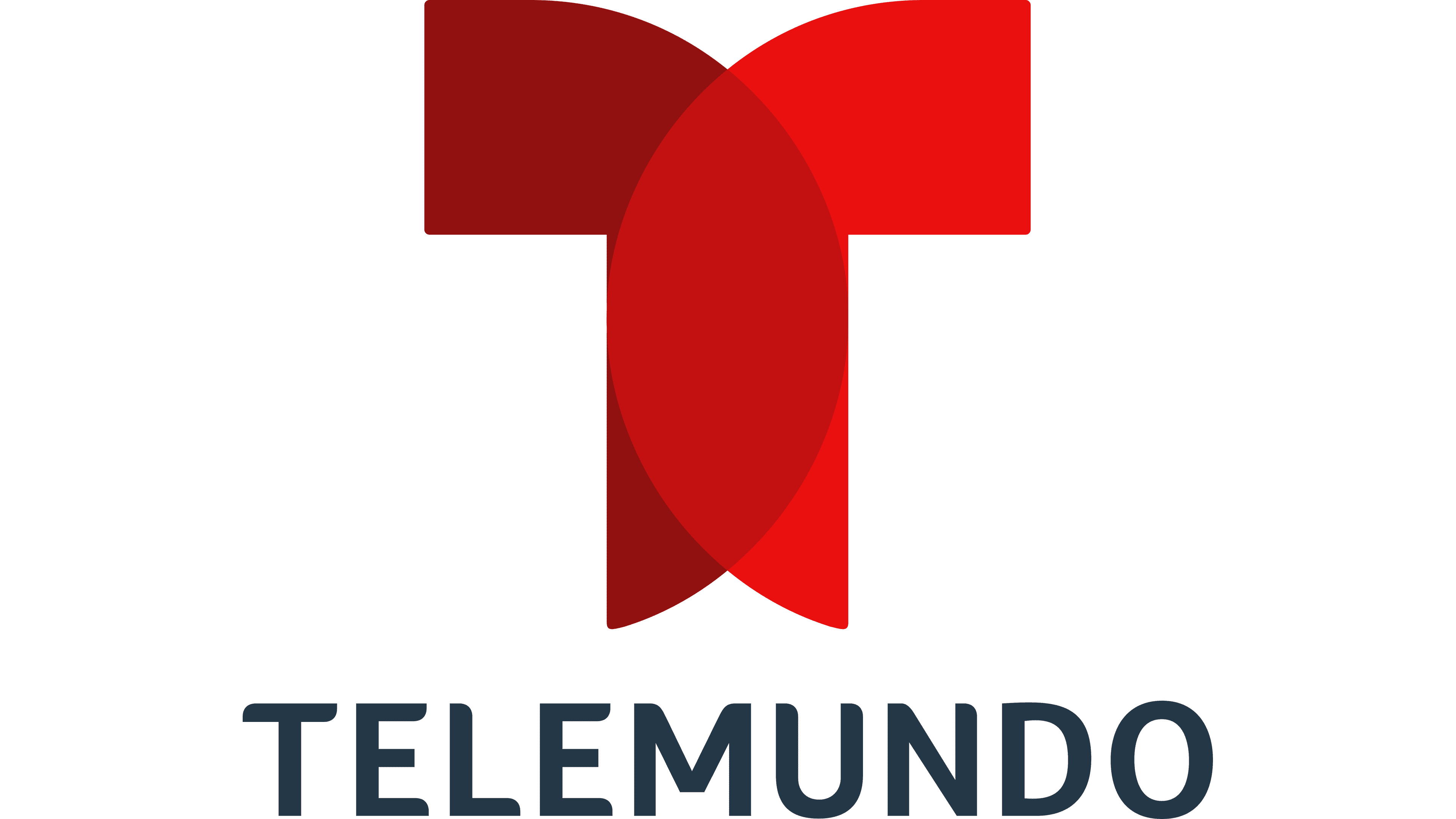Telemundo Logo
Telemundo, an American Spanish-language terrestrial television network, is owned by NBCUniversal Telemundo Enterprises, a division of NBCUniversal, itself a subsidiary of Comcast. Founded in 1984, Telemundo caters primarily to Hispanic and Latino American audiences, providing a mix of original and imported programming. Its content includes telenovelas, sports, reality television, news programming, and films, often either produced in Spanish or dubbed. Telemundo’s headquarters are in Miami, Florida. The network has a significant influence in the U.S. media landscape, offering an alternative to dominant English-language broadcasters and reflecting the diverse cultural landscape of the Hispanic community.
Meaning and history
Telemundo, a prominent Spanish-language television network in the United States, has a rich history that traces back to its inception in 1954 as WKAQ-TV, a local TV station in Puerto Rico. In 1984, the network was rebranded as Telemundo, marking the beginning of its journey as a national broadcaster. The initial years focused on building a viewer base among the Hispanic community, offering a blend of telenovelas, news, and variety shows.
In the 1990s, Telemundo underwent significant changes. It was acquired by Reliance Capital Group in 1988 and later by Sony Pictures Entertainment and Liberty Media in 1997. This era saw an increase in original programming, a strategy that helped distinguish Telemundo from its competitors. The network also began investing in high-quality telenovelas, directly challenging established players in Latin American markets.
The early 2000s were pivotal for Telemundo. In 2001, it became a part of NBCUniversal, a subsidiary of Comcast, marking a new phase of growth and investment. This acquisition allowed Telemundo to enhance its production capabilities and expand its reach. The network started producing more U.S.-based original content, targeting the diverse and growing Hispanic audience in America.
Telemundo’s programming strategy has always been innovative. It has ventured beyond traditional telenovelas to include reality TV, sports, and news. The network made significant strides in sports broadcasting, securing rights to major events like FIFA World Cup soccer matches. Its news division, Telemundo News, has become a vital source of information for Spanish-speaking viewers, providing extensive coverage of both U.S. and international events.
Telemundo’s influence extends beyond television. With a robust digital presence, it caters to a younger, tech-savvy audience through online platforms and social media. The network continues to play a crucial role in reflecting and shaping the Hispanic cultural landscape in the United States, resonating with a community that values both its heritage and its American identity.
What is Telemundo?
Telemundo is a leading American Spanish-language television network, known for its diverse array of original programming, including telenovelas, sports, reality shows, and news. Owned by NBCUniversal, it serves as a primary entertainment and information source for the Hispanic community in the United States, distinguishing itself with vibrant, culturally resonant content.
1984 – 1987
The logo a stark, minimalist design with a bold, sans-serif typeface. The word “NetSpan” is written in a solid black color, with the “Net” part slightly elevated above the “Span,” creating a visual hierarchy. The typography is straightforward, with a modernistic approach, emphasizing clarity and legibility. The overall simplicity of the design suggests a no-frills, direct approach to branding, aimed at a contemporary audience seeking straightforwardness and reliability. The absence of additional graphics or emblems focuses the viewer’s attention solely on the brand name, showcasing confidence in the name’s power and recognizability.
1987
The updated logo transitions to a bolder and more pronounced presentation. “TELEMUNDO” is set in heavy, blocky letters, contained within an encompassing oval shape, which adds a sense of unity and boundary to the design. This typographic choice conveys solidity and presence, with the symmetry of the oval implying inclusivity and global reach. The stark black and white color scheme remains, maintaining the strong visual contrast seen in the previous logo. However, the addition of the oval frame around the text gives the logo a finished look, suggesting a world or globe, which may symbolize the network’s international scope and outreach. The characters are tightly packed, possibly to signify the network’s cohesive and interconnected content. Each letter is capitalized, denoting importance and stability, with uniform thickness that reinforces the strength of the brand. This design evolution reflects a step towards a more defined and assertive brand identity.
1987 – 1992
This iteration of the logo introduces a dynamic, spherical emblem, a stark departure from the previous oval frame. The sphere is rendered in a vivid red, imbued with curved white lines suggesting motion and global connectivity. The word “TELEMUNDO” beneath it adopts a more streamlined typeface, contrasting the emblem’s curvature with its own angularity. The use of red, often associated with passion and energy, injects vitality into the brand, while the globe-like icon could represent the network’s worldwide reach and impact. The text’s black hue grounds the design, providing a solid foundation for the floating, energetic globe. This design choice reflects a modernizing brand, aiming for a fresh, contemporary image that captures attention and evokes a sense of liveliness and expansion.
1992 – 1997
In this evolution, the logo departs from the spherical motif, embracing a bold ‘T’ intersected by a swooping green circle. The ‘T’ is saturated in blue, symbolizing trust and depth, while the green circle may represent growth and vibrancy, elements that align with the network’s innovative spirit. Below, “TELEMUNDO” is written in a plain, sans-serif typeface, black on white, signifying straightforward communication. The logo’s colors, bright and contrasting, are a nod to the network’s lively and diverse broadcasting palette. This design represents a significant shift towards simplicity and abstraction, focusing on the initial of the network’s name to embed brand recognition. The overall aesthetic is clean, modern, and indicative of a forward-thinking media entity.
1997 – 2000
The logo now takes a textured approach, giving it depth and a tactile quality. The central ‘T’, now in a rich blue, overlays what appears to be a textured brown background, evoking earthiness or a global reach rooted in cultural depth. A crescent, colored in gradients of green, intersects the ‘T’, suggesting dynamism and a natural element. Below, “TELEMUNDO” is set in a simpler typeface than the previous iteration, maintaining the brand’s straightforward communication but with a more refined touch. The 3D effect of the ‘T’ adds a layer of sophistication and modernity, signaling the network’s progress and its embrace of emerging broadcasting dimensions. This logo’s intricate design elements represent a blend of tradition and innovation, mirroring the network’s balance of classic programming and contemporary offerings.
2000 – 2012
In this logo, Telemundo adopts a stark, streamlined design. The emblem features a bold, red ‘T’ with a sweeping curve slicing through it, imparting a sense of motion and change. Red, a color denoting passion and energy, is now the central theme, reflecting the network’s dynamic and vibrant identity. “TELEMUNDO” appears below in a simple, clean font, contrasting with the emblem’s curvature. The previous logo’s earthy textures and 3D effects have been shed, favoring a flatter, more graphic look. This minimalistic approach signifies a modern era for the brand, focusing on visual impact and easy recognition. The prominent ‘T’ is not just the network’s initial but also stands as a symbol on its own, perhaps representing a landmark or beacon in Spanish-language television. This logo marks a return to basic geometric forms, emphasizing clarity and a no-nonsense approach to branding.
2012 – 2018
The logo now takes a dimensional leap with a glossy, ribbon-like ‘T’ that folds over itself, suggesting depth and fluidity. The rich gradient of red hues gives the ‘T’ a lustrous, almost metallic look, indicating a premium and contemporary feel. The boldness of the red captures the eye, while the dimensional twists imply innovation and a modern approach. Below, the word “TELEMUNDO” is set in a straightforward, sans-serif typeface, offering a grounded contrast to the emblem’s complexity. This design shift from the previous flat and geometric logo to one with a sense of volume and tactile quality marks an evolution in the brand’s identity, aiming for a more dynamic, engaging visual presence. It’s a move that speaks to the network’s adaptability and commitment to staying current in a rapidly changing media landscape.
2018 – Today
The logo retains its iconic red ‘T’ but reverts to a simpler, flat design, abandoning the previous logo’s gloss and depth. The red hue remains vibrant, symbolizing the network’s energy and passion. The ‘T’ itself is stylized with a slight curve at the bottom, giving a subtle nod to modernity. This flat design aligns with contemporary trends of simplicity and digital readability. Below, “TELEMUNDO” is presented in a dark, slate gray, maintaining a clean and minimalistic sans-serif font. This color choice for the text offers a softer contrast than the stark black of the previous iteration, suggesting a more modern and approachable brand. The logo’s evolution seems to follow a path of refined simplicity, focusing on a direct and uncluttered visual that is easily recognizable and adaptable to various media platforms.



















